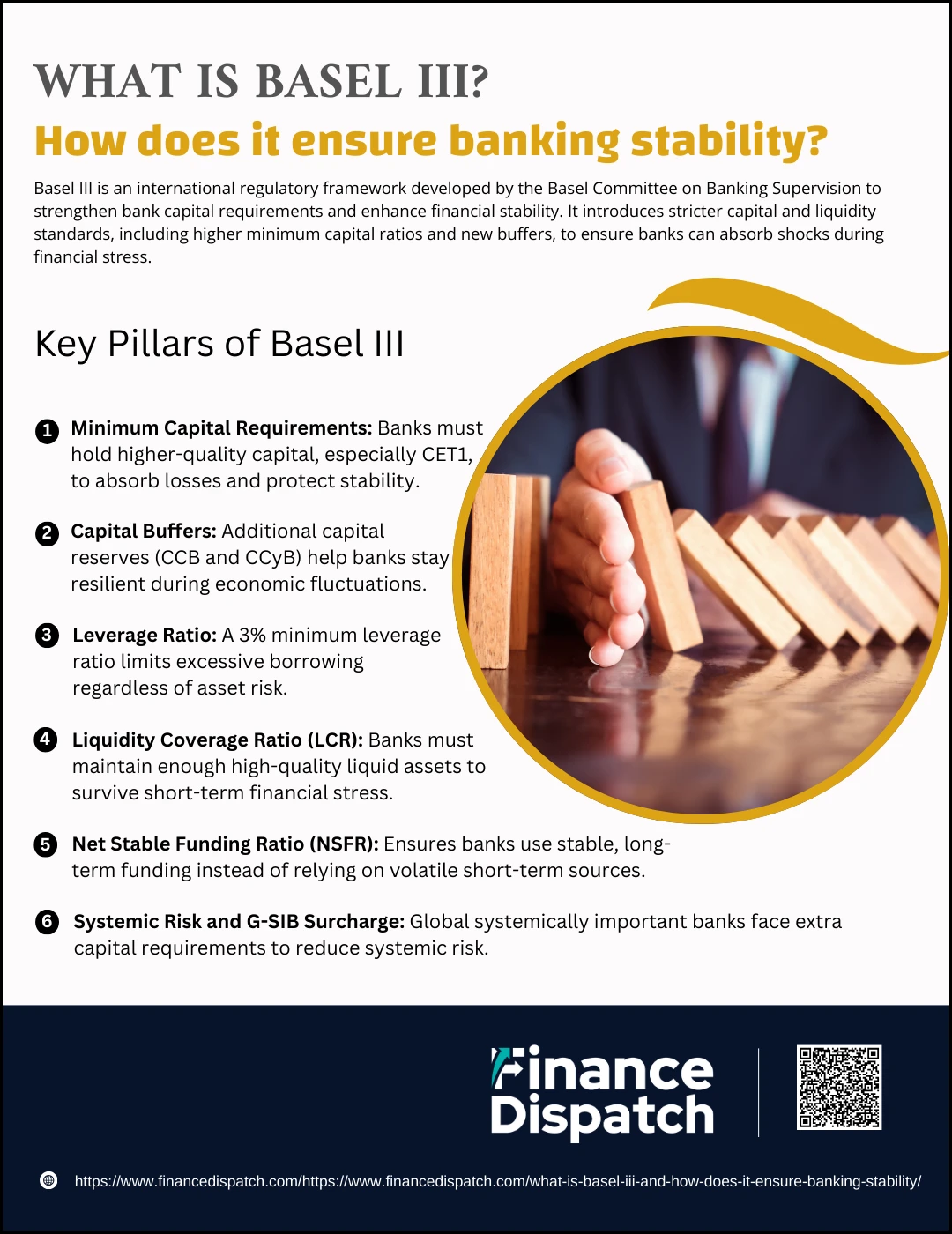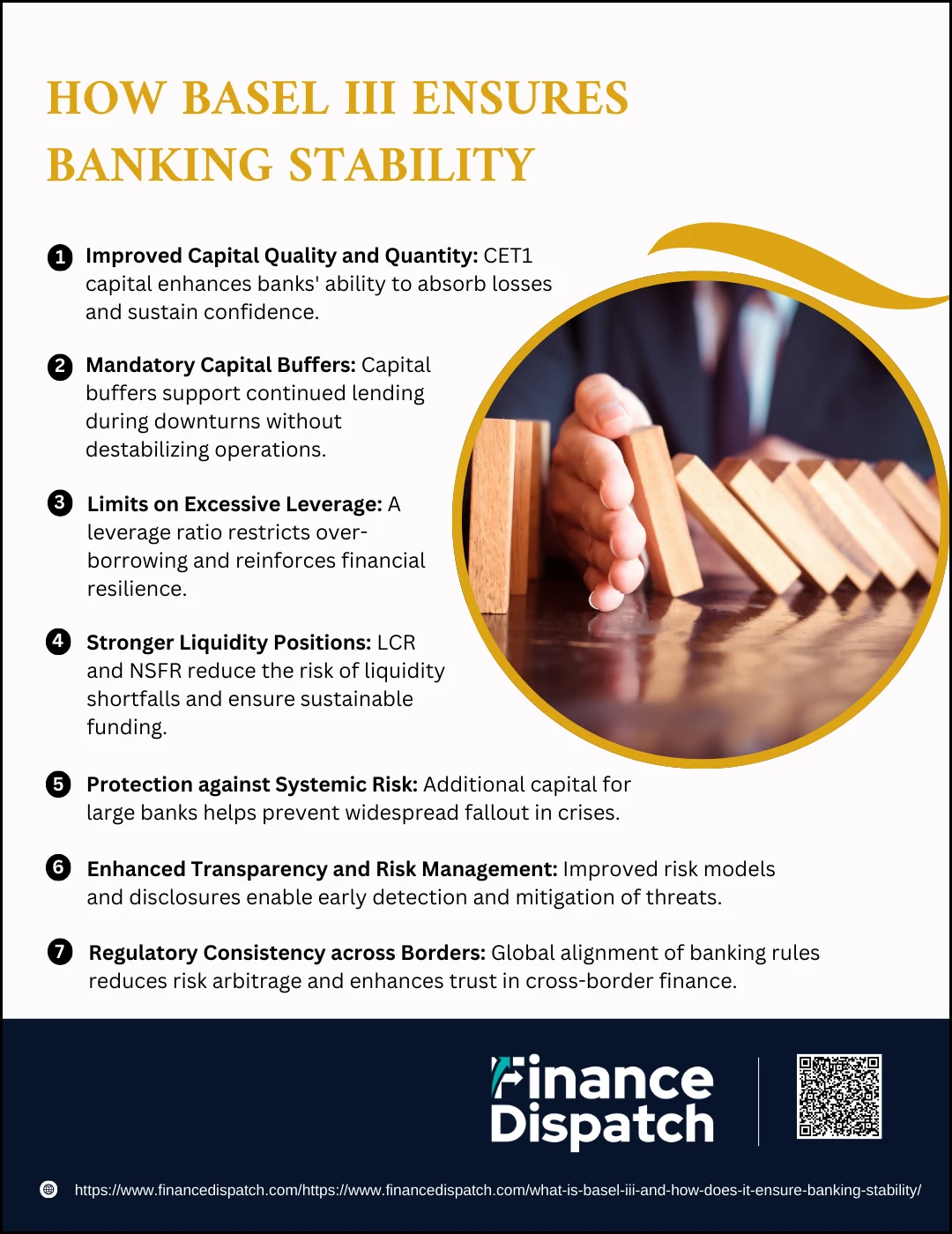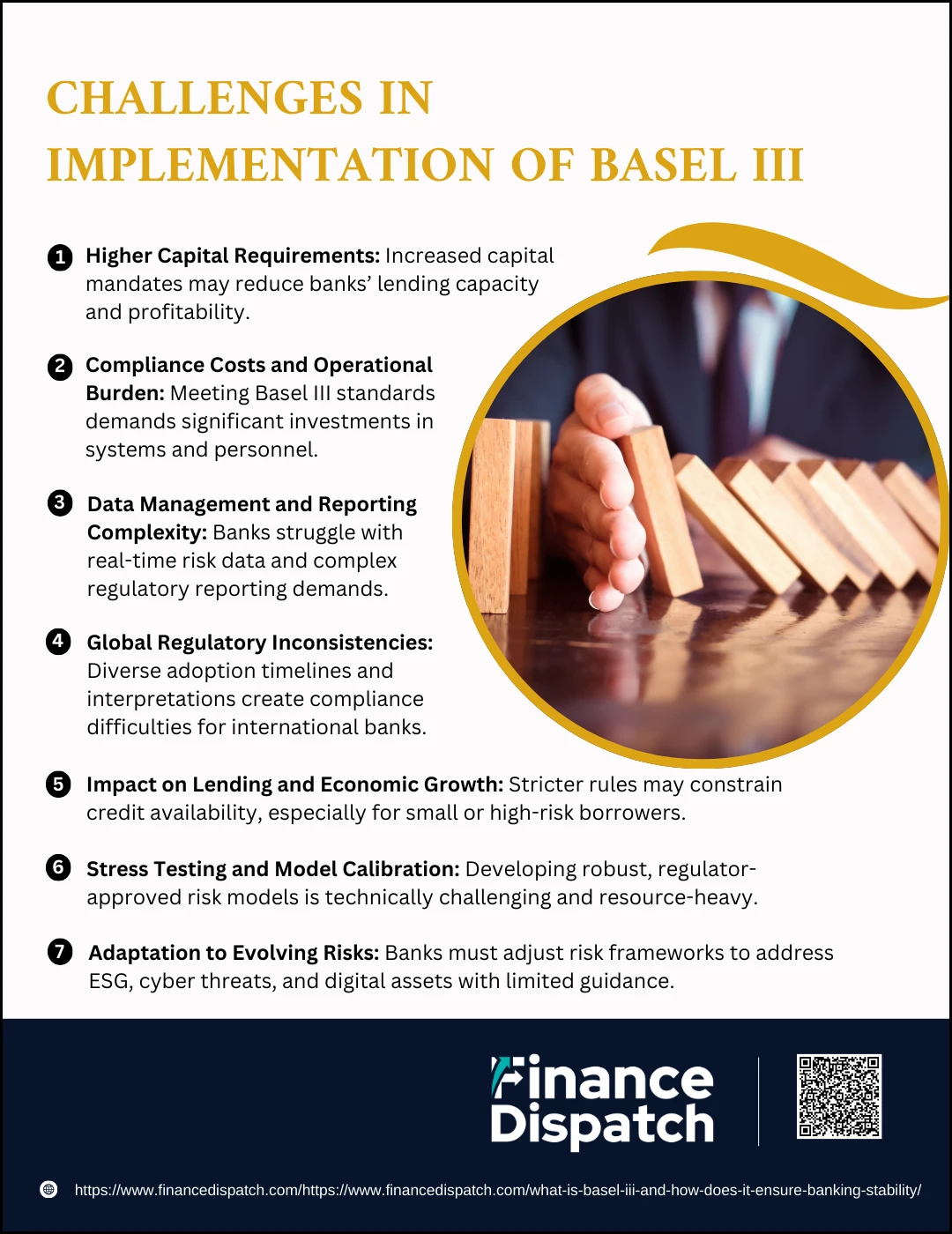In the aftermath of the 2007–2008 global financial crisis, the world witnessed just how vulnerable the banking system could be in times of economic stress. In response, international regulators introduced Basel III—a comprehensive set of banking reforms designed to strengthen financial institutions and prevent future collapses. Developed by the Basel Committee on Banking Supervision, Basel III sets stricter requirements for capital, leverage, and liquidity, aiming to ensure that banks remain resilient even in turbulent conditions. This article explores what Basel III is and how its principles are designed to uphold the stability of the global banking system.
What is Basel III?
Basel III is an international regulatory framework developed by the Basel Committee on Banking Supervision to enhance the strength and resilience of the banking sector. Introduced in response to the 2008 financial crisis, Basel III builds upon the earlier Basel I and II accords by introducing stricter capital requirements, leverage limits, and liquidity standards. Its primary goal is to ensure that banks hold sufficient high-quality capital to absorb losses, manage risk more effectively, and maintain adequate liquidity during periods of financial stress. By doing so, Basel III aims to create a safer and more stable global banking system capable of withstanding economic shocks.
 Key Pillars of Basel III
Key Pillars of Basel III
At the heart of Basel III lies a robust framework aimed at strengthening the global banking system’s ability to absorb financial shocks and protect depositors. Developed in response to the vulnerabilities exposed by the 2008 financial crisis, Basel III introduces comprehensive reforms that focus on enhancing capital quality, reducing excessive leverage, and ensuring sufficient liquidity. These pillars work together to improve the resilience of individual banks and the overall stability of the financial system.
1. Minimum Capital Requirements
Basel III raises the bar for how much capital banks must hold, especially in the form of Common Equity Tier 1 (CET1), the highest quality of capital. This ensures that banks have a strong financial cushion to absorb unexpected losses without collapsing or requiring government bailouts.
2. Capital Buffers
In addition to the minimum capital thresholds, Basel III introduces two key buffers:
- Capital Conservation Buffer (CCB): A 2.5% reserve of CET1 capital that banks must maintain to avoid restrictions on dividends and bonuses.
- Countercyclical Capital Buffer (CCyB): A flexible buffer, up to 2.5%, that regulators can activate during credit booms to prevent overheating in the financial sector.
3. Leverage Ratio
To guard against excessive borrowing, Basel III mandates a minimum leverage ratio of 3%. Unlike risk-based ratios, the leverage ratio applies to all assets, ensuring that banks maintain a base level of capital regardless of asset risk ratings.
4. Liquidity Coverage Ratio (LCR)
The LCR requires banks to hold enough high-quality liquid assets (like government bonds and cash) to survive a severe 30-day financial stress scenario. This minimizes the risk of a sudden liquidity crunch.
5. Net Stable Funding Ratio (NSFR)
This long-term liquidity measure ensures that banks fund their operations with stable sources, such as long-term deposits or equity, rather than relying excessively on short-term, volatile funding.
6. Systemic Risk and G-SIB Surcharge
Basel III introduces an additional capital surcharge for Global Systemically Important Banks (G-SIBs), which are large, interconnected institutions whose failure could trigger systemic crises. This extra buffer, ranging from 1% to 3.5%, is intended to reduce the risk they pose to the financial system.
 How Basel III Ensures Banking Stability
How Basel III Ensures Banking Stability
Basel III was introduced as a direct response to the vulnerabilities exposed during the 2008 global financial crisis. It provides a stronger regulatory foundation to help banks withstand economic shocks, avoid insolvency, and continue providing credit even during periods of market stress. The key to its effectiveness lies in its comprehensive approach—strengthening capital bases, managing leverage, ensuring liquidity, and enhancing transparency. These reforms are not just rules; they are protective mechanisms designed to reinforce the health of banks, and by extension, the stability of the global financial system.
1. Improved Capital Quality and Quantity
Basel III emphasizes holding more high-quality capital—especially Common Equity Tier 1 (CET1)—which consists mainly of common shares and retained earnings. This ensures that banks have a strong buffer to absorb losses, reducing the need for government bailouts and maintaining public confidence during financial distress.
2. Mandatory Capital Buffers
Two important buffers—Capital Conservation Buffer (2.5%) and Countercyclical Capital Buffer (up to 2.5%)—require banks to accumulate extra capital during times of economic strength. These reserves can be released in downturns, allowing banks to continue lending and support the economy without immediately cutting operations or laying off workers.
3. Limits on Excessive Leverage
The introduction of a non-risk-based leverage ratio limits how much a bank can borrow relative to its capital. This backstop ensures that even if a bank underestimates the riskiness of its assets, it cannot become dangerously overleveraged. It prevents risky growth fueled by debt and supports financial resilience.
4. Stronger Liquidity Positions
Basel III mandates two key liquidity measures:
- The Liquidity Coverage Ratio (LCR) ensures that banks hold enough high-quality liquid assets to survive a 30-day stress period.
- The Net Stable Funding Ratio (NSFR) requires banks to fund their assets with stable sources to reduce reliance on short-term borrowing.
Together, these help prevent a sudden cash crunch that can escalate into a crisis.
5. Protection Against Systemic Risk
Some banks are “too big to fail.” Basel III introduces extra requirements for Global Systemically Important Banks (G-SIBs), such as higher capital surcharges. This ensures that if a large bank faces trouble, it has a larger cushion, reducing the likelihood of its failure triggering widespread panic or collapse in the financial system.
6. Enhanced Transparency and Risk Management
Basel III pushes banks to improve internal risk models, disclose more data to regulators and the public, and adopt better governance practices. With more accurate, real-time risk data and clearer financial reporting, stakeholders can identify weaknesses early and take preventive measures.
7. Regulatory Consistency Across Borders
Basel III is designed as a global standard, ensuring banks in different countries operate under similar rules. This coordination reduces regulatory arbitrage (where banks shift risky operations to jurisdictions with laxer rules), supports international financial integration, and strengthens trust in cross-border banking.
Core Components of Basel III
Basel III introduced a wide-ranging set of reforms aimed at improving the resilience of banks and reducing systemic risks in the financial system. These reforms focus on enhancing the quality of capital, controlling leverage, improving liquidity, and introducing safeguards against economic cycles and large institutional failures. Together, these core components create a more stable and transparent banking framework that better protects economies from future crises.
1. Common Equity Tier 1 (CET1) Requirements
Banks must hold a higher percentage of their capital as CET1, the most secure and loss-absorbing form of capital, to improve their ability to handle financial stress.
2. Capital Conservation Buffer (CCB)
A 2.5% buffer of CET1 capital is required in addition to the minimum capital, helping banks conserve capital in good times to use during downturns.
3. Countercyclical Capital Buffer (CCyB)
Regulators can activate this buffer during periods of excessive credit growth, requiring banks to hold more capital to absorb future losses.
4. Leverage Ratio
A non-risk-based ratio that limits the total exposure a bank can take relative to its Tier 1 capital, helping prevent dangerous levels of debt.
5. Liquidity Coverage Ratio (LCR)
Requires banks to maintain enough high-quality liquid assets to survive a 30-day stress period, ensuring short-term resilience.
6. Net Stable Funding Ratio (NSFR)
Ensures banks fund their activities with stable sources over a one-year horizon, reducing reliance on volatile short-term funding.
7. Global Systemically Important Bank (G-SIB) Surcharge
Additional capital requirements for the largest and most interconnected banks to minimize the risk they pose to the global financial system.
8. Improved Risk Management and Disclosures
Basel III encourages banks to enhance their internal risk models, conduct regular stress tests, and increase transparency through improved disclosures to regulators and the public.
Basel III vs Basel II: What’s New?
While Basel II aimed to refine how banks assess risk and manage capital, the 2008 financial crisis exposed its critical flaws—particularly in underestimating systemic risks and liquidity vulnerabilities. Basel III was introduced as an upgraded framework to address these shortcomings. It builds on the foundation of Basel II but introduces significant changes in capital quality, leverage control, liquidity standards, and systemic risk management to create a stronger and more resilient banking system.
| Feature | Basel II | Basel III |
| Capital Requirements | Focused on total capital (8%) with Tier 1 at 4% | CET1 raised to 4.5%, Tier 1 to 6%, total remains at 8% |
| Capital Quality | Less emphasis on capital composition | Emphasis on high-quality capital like CET1 |
| Capital Buffers | Not required | Introduced Capital Conservation Buffer (2.5%) and CCyB (up to 2.5%) |
| Leverage Ratio | Not explicitly required | Introduced 3% minimum leverage ratio |
| Liquidity Standards | Not addressed explicitly | Introduced LCR and NSFR for short- and long-term liquidity |
| Systemic Risk Controls | Limited consideration | Additional requirements for G-SIBs to address systemic risk |
| Risk Coverage | Credit and market risks; limited operational risk coverage | Broader coverage including operational, liquidity, and systemic risks |
| Internal Models for Risk | Encouraged bank-developed internal models | More constraints on internal models; use of standardized approaches emphasized |
| Implementation Timeline | Rolled out in 2004 | Phased implementation, final phase begins July 1, 2025 |
 Challenges in Implementation of Basel III
Challenges in Implementation of Basel III
Basel III represents a major leap forward in banking regulation, designed to prevent the kinds of systemic failures witnessed during the 2008 financial crisis. However, translating its principles into practice has proven complex and demanding. Banks are not only required to strengthen their capital and liquidity positions but also to overhaul internal systems, align with shifting regulatory timelines, and adapt to a more rigorous risk management culture. The multifaceted nature of Basel III has introduced a host of implementation challenges that differ by institution size, jurisdiction, and market conditions. Below are the key obstacles faced during its global rollout:
1. Higher Capital Requirements
Basel III mandates that banks hold more high-quality capital, particularly Common Equity Tier 1 (CET1). While this enhances financial resilience, it also limits the funds available for income-generating activities like lending and investment. For many institutions—especially smaller banks—raising capital quickly can be difficult, forcing them to scale down operations or reduce lending.
2. Compliance Costs and Operational Burden
Implementing Basel III is resource-intensive. Banks must invest heavily in technology, update policies and procedures, and recruit or train staff to understand and manage new regulatory obligations. These requirements place significant financial and human resource pressures on institutions, particularly in developing economies or smaller banking sectors.
3. Data Management and Reporting Complexity
Basel III introduces stringent requirements for real-time data collection, risk aggregation, and regulatory reporting. Many banks are not equipped with the infrastructure needed to gather, process, and report data at the required speed and accuracy. Upgrading IT systems and ensuring data quality across multiple departments is a major undertaking.
4. Global Regulatory Inconsistencies
Although Basel III is intended as a global standard, individual countries adopt and interpret its requirements differently. Varying implementation schedules, supervisory expectations, and regulatory thresholds can create a fragmented compliance environment—especially for multinational banks that must align with multiple jurisdictions.
5. Impact on Lending and Economic Growth
The tighter capital and liquidity requirements may lead banks to reduce lending activities, especially to higher-risk sectors like small businesses or startups. This can slow credit expansion and dampen economic growth in the short term, raising concerns among policymakers and financial institutions alike.
6. Stress Testing and Model Calibration
Basel III promotes the use of internal models for risk assessment, but regulators now impose more scrutiny on their design and validation. Developing models that are robust, transparent, and acceptable to regulators can be technically challenging and time-consuming, requiring significant expertise and coordination.
7. Adaptation to Evolving Risks
Basel III is increasingly expected to address emerging threats such as environmental risks (ESG), cybersecurity, and digital assets like cryptocurrencies. Banks must stay agile and continuously adapt their risk management frameworks to cover these evolving domains, often with limited regulatory clarity or historical data.
Future Outlook and Reforms of Basel III
As global financial systems evolve and face new risks, the Basel III framework is also undergoing updates to stay relevant and effective. The future of Basel III lies in refining existing regulations, incorporating lessons from real-world implementation, and expanding its scope to address emerging challenges like climate risk, digital innovation, and global interconnectedness. These ongoing and upcoming reforms aim to make the banking sector even more resilient, transparent, and adaptable to both traditional and non-traditional financial threats.
1. Basel III Endgame Implementation (2025 and Beyond)
Final rules—known as the Basel III Endgame—are set to begin on July 1, 2025, with a phased approach over three years. These reforms adjust how banks calculate risk-weighted assets and strengthen the consistency of capital requirements.
2. Greater Emphasis on Output Floors
A key reform involves setting a minimum level (72.5%) for risk-weighted assets calculated using internal models, ensuring that banks cannot use overly optimistic models to lower capital requirements.
3. Focus on Operational Risk
New standardized approaches for calculating operational risk—like system failures or fraud—replace complex internal models, making risk assessments more uniform and transparent.
4. Integration of ESG and Climate Risks
Regulators are increasingly encouraging banks to factor environmental, social, and governance (ESG) risks into capital planning and stress testing frameworks to future-proof the industry.
5. Enhanced Oversight of Crypto and Digital Assets
Basel III is evolving to address risks related to crypto assets, including capital charges and liquidity considerations to manage their volatility and potential systemic impact.
6. Stronger Supervisory and Reporting Standards
New reforms emphasize consistent, real-time data reporting and enhanced disclosures, enabling regulators to detect vulnerabilities early and respond more effectively.
7. Tailored Approaches for Smaller Banks
While Basel III focuses on large institutions, future reforms may refine requirements to better suit small and medium-sized banks without compromising overall stability.
8. Harmonization Across Jurisdictions
The Basel Committee continues to promote uniform adoption of rules worldwide, reducing regulatory arbitrage and ensuring fair competition among global banks.
Conclusion
Basel III represents a pivotal shift in global banking regulation, designed to fortify financial institutions against future crises by enhancing capital quality, limiting leverage, and strengthening liquidity. While its implementation has posed significant challenges for banks and regulators alike, the long-term benefits of a more resilient and transparent banking system are undeniable. As the Basel III Endgame approaches full rollout, and with ongoing reforms addressing emerging risks such as ESG factors and digital assets, the framework continues to evolve in response to a changing financial landscape. Ultimately, Basel III serves as a cornerstone in promoting trust, stability, and sustainable growth within the global financial system.



